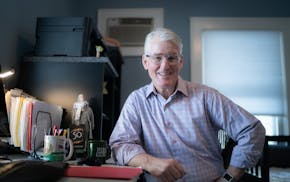It might seem as if the pandemic era really cemented e-commerce as mainstream form of retailing. But e-commerce is not so new anymore and we are already on to the next big thing.
It's called experiential commerce at home, a term that doesn't show up in a Google search but is a key concept in research published online by Loup Ventures, a Minneapolis venture capital firm that routinely shares thoughts on companies, technologies and culture.
Loup co-founder Gene Munster said this week that they didn't really come up with the notion so much as learn about it from the founders of a Silicon Valley company called Enjoy Technology Inc. It must have been persuasive because Loup invested more than three years ago, and Enjoy just announced its coming listing shares through a merger with one of those blank-check companies.
Loup argued that there are just two strategies to win in retail, by providing shoppers more convenience or giving them a richer experience. Enjoy, by bringing a rolling store right to a consumer's home, hopes to do both.
As investors, the Loup partners have a rooting interest in Enjoy, but if it's not Enjoy that perfects this model, somebody else will. It makes that much sense.
This coming shift in retailing is just another of a long series of them, like the era of the American shopping mall ushered in by the opening of Southdale Center in Edina in 1956.
Another followed when Walmart rolled out of Arkansas in the 1980s and 1990s, developing such deep operational expertise along the way that it could crush competitors with lower prices and broader selection.
Then e-commerce came along, and in time shopping over the internet on the Monday after Thanksgiving became as big a deal as shopping in stores had been on Black Friday.
The appeal of online shopping wasn't really about lower price, either, but a level of convenience even a vast Walmart store couldn't match.
Amazon.com, under founder Jeff Bezos, held tightly to the notion that no matter how convenient shopping becomes, the customer still won't be satisfied. You can now shop from Amazon by asking an Alexa device to get something for you.
The better customer experience approach often gets rounded off as "better service," but it's far more complex than that.
A better experience in the store is one way to explain how Target could prosper alongside Walmart. Target shared DNA with a department store and had the skill to delight and surprise customers with the kind of fashionable items Walmart didn't seem to know how to sell.
The term customer experience now shows up all over business. It's why you get an e-mail asking you how it went after visiting a health system clinic, asking not about whether the prescribed medication really worked but how you felt about the whole process.
If you need to be reminded how indifferent companies used to be, think back to when relatively expensive technology products were sold from a metal rack in a warehouse-turned-store.
One of the things that allowed Apple to become the global juggernaut we now know was its decision to shape the buying experience of its customer by selling through its own stores.
One idea was placing its Genius Bar in the back, where staffers solved a lot of customer problems right on the spot. "Some of the most successful salespeople in Apple's chain are their geniuses, and you don't even know they're selling to you," Munster said.
Apple is one of the best at delivering a great experience in a store. Walmart does well offering convenience in a store. Amazon sells online and leads with its unparalleled convenience.
But as for creating a better experience, maybe Amazon doesn't really know how to do that. And, said Munster, Apple isn't any better at online retailing than anyone else.
Apple still cares about its customers' experience, though, or else it wouldn't have invested so much in things like packaging. Turn over the white box of an Apple Watch and consumers can see how even the clasps on the bottom have been carefully designed.
Enjoy co-founder and CEO Ron Johnson, who grew up not far from Southdale, was the former Target executive who went to Apple to develop its retailing business. He later said the Apple stores were so different from mainstream retail that it took three or four years for them to really catch on.
Johnson later served as CEO of J.C. Penney Co., where he initiated a course correction so abrupt that his 17-month tenure will be remembered for its stomach-churning sales declines. He co-founded Enjoy in 2014.
"On the most basic level, [Enjoy] is bringing the Apple Store, all the aspects of it, the shopping piece and the support, into your home," Munster said.
Enjoy is only just getting started with Apple in a few markets, but it brings technology products to consumers working with AT&T, London-based BT Group and Rogers Communications of Canada as well.
Its people show up at the appointed hour, products in hand, to show off features, complete the setup and suggest accessories, like a case for a new iPad.
This might resemble what the Geek Squad does for Best Buy Co., although instead of a paid service call to get a balky device working, Enjoy is there on a sales call, too.
The switch to commerce in the home will be enabled by scheduling and routing technology that wasn't available when the Kirby Co. vacuum sales rep visited your parents 50 years ago. But this looks a little like the Kirby approach that insisted consumers would buy a premium vacuum cleaner only after being shown what it can do in their own living room.
Enjoy's approach isn't going to work for every product category or company, and budget-conscious consumers probably aren't a good target market. Yet technology products are only going to become more important in the lives of consumers.
And customers will want them to work. These products can't just work in the store, either, but in their hands and seated on their own couch.

Schafer: What do you really need to retire?

Schafer: How doing business can be a bit more like Christmas morning

Schafer: There won't soon be another opportunity to rethink the I-94 corridor

Schafer: The fruits of Honeywell's long-game dedication to quantum computer now being seen


